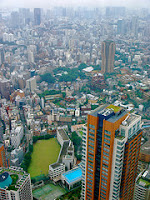



On 21 June, we 'sailed' to Asakusa via a Sumida River cruise, passing near Odaiba and Tokyo Bay up the river to the giant Flamme d'Or of Philippe Starck's, disembarking amidst the throngs of tourists and rickshaw runners, and tempura restaurants in summer heat. Through the Thunder Gate (Kaminari-mon) and the hot afternoon we strolled up the Nakamise Dori, tasting some of the traditional culinary intrigues and browsing the many traditional products and trinkets, conveniently conglomerated for tourists: furoshiki, swords, knives, cloth, cords, geta, yukata, waving cats, playful children's toys, Buddhist prayer beads, boxwood combs, moochi, rice crackers, confectionary, and so on. One store selling sembae rice crackers claims to be over 200 years old. The heat was taking its toll so we ambled at a leisurely pace, punctuated by cold drinks from the numerous vending machines, hovering in the shade of the temple gardens and glad of the breeze that accompanied our return river journey. For Mum and Dad it was the contrast from frozen sub-zero Oberon to sweaty, humid and mostly breezeless Tokyo before the rainy season set in. We had delicious skewer dinner - kushiage (ginko nuts, cheese-filled green peppers, chicken skin, mince balls, chicken with shallot, mushroom). Pictured above is the strangely demi-pervasive Manx-looking (but actually bobtailed) variety of feline domesticus found in Japan, also along with a semi-Manx cat (i.e. literally with a half-lengthed tail by Australian standards). The Japanese Bobtail is a breed of cat with a cropped tail more closely resembling the tail of a rabbit than that of an ordinary feline. The short tail is a cat body type genetic mutation caused by the expression of a recessive gene [Wikipedia]. It has been depicted in Japanese art for many centuries.




 The following day, at Ginza Mitsukoshi Mum and I browsed through the traditional Japanese gifts, thence Itoya washi shop and we attended the one-act session of Kabuki theatre (at the Edo-style Kabuki-za building), clambering up floor steep flights of stairs to the top remote gallery. Completely destroyed in World War II, it has since been completely reconstructed. A famous actor was introducing his grandson for the first time to act on the Kabuki stage: the child was 2 years old! Fashioned from tied fabric in the style of dyeing material formed into a lampshade is the sculpturesque creation pictured at Mitsukoshi, Ginza. Ginza means 'silver mint', so-called due its proximity to where early shogunate governments minted coins from 1612 to 1800. At Gankko (stubborn) restaurant we ate a delightful sushi/sashimi bento box with tempura, miso and rice and pickles laid out exquisitely and cooked (or not, in the case of sushi) to perfection. Afterwards, we walked to the Imperial Palace garden. Only open to the public once per annum (January 2 on the Emperor's birthday), this is otherwise about as close as you get to the Edo-style fortress protected by moats and guards.
The following day, at Ginza Mitsukoshi Mum and I browsed through the traditional Japanese gifts, thence Itoya washi shop and we attended the one-act session of Kabuki theatre (at the Edo-style Kabuki-za building), clambering up floor steep flights of stairs to the top remote gallery. Completely destroyed in World War II, it has since been completely reconstructed. A famous actor was introducing his grandson for the first time to act on the Kabuki stage: the child was 2 years old! Fashioned from tied fabric in the style of dyeing material formed into a lampshade is the sculpturesque creation pictured at Mitsukoshi, Ginza. Ginza means 'silver mint', so-called due its proximity to where early shogunate governments minted coins from 1612 to 1800. At Gankko (stubborn) restaurant we ate a delightful sushi/sashimi bento box with tempura, miso and rice and pickles laid out exquisitely and cooked (or not, in the case of sushi) to perfection. Afterwards, we walked to the Imperial Palace garden. Only open to the public once per annum (January 2 on the Emperor's birthday), this is otherwise about as close as you get to the Edo-style fortress protected by moats and guards. On Sunday 24 June, at Roppongi Hills we visited Mori Art Museum and Tokyo City View up the 54 floors in the edifice commemorating Mori's richness above Louise Bourgeois' giant bronze spider sculpture. Inside, the highlight was the Le Corbusier exhibition. Full photo documentation availbale at Flickr Mum+Dad in Japan set
On Sunday 24 June, at Roppongi Hills we visited Mori Art Museum and Tokyo City View up the 54 floors in the edifice commemorating Mori's richness above Louise Bourgeois' giant bronze spider sculpture. Inside, the highlight was the Le Corbusier exhibition. Full photo documentation availbale at Flickr Mum+Dad in Japan set





